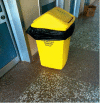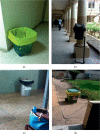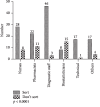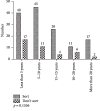Medical Waste-Sorting and Management Practices in Five Hospitals in Ghana
- PMID: 32190061
- PMCID: PMC7073495
- DOI: 10.1155/2020/2934296
Medical Waste-Sorting and Management Practices in Five Hospitals in Ghana
Abstract
Hospital waste management in Ghana faces the risk of cross-contamination from the lack of thorough sorting of the waste at the points of generation, codisposal of hazardous and nonhazardous waste types, and use of open-fire pits and substandard incinerators for burning infectious waste. This has increased the potential for the spread of infections and chemical pollutants. A cross-sectional study was conducted in five hospitals in Ghana to assess behavioral patterns on waste sorting and the effectiveness of hospital waste management in Ghana. A total of 250 questionnaires were distributed purposively to some staff of the five hospitals to assess workers' perceptions on medical waste sorting and handling. Additionally, focused group discussions and transect walks were adopted to examine the current collection, storage, treatment, and disposal methods used in the health facilities. Chi-square analyses showed significant differences in waste-sorting behavior based only on occupation (p < 0.0001, n=180) and not on gender, education, or experience in the health sector. Even though contaminated sharps were separated into brown safety boxes, color coding for other infectious waste containers was inconsistent across the health facilities. The study revealed that incineration is still the modal method of treatment in Ghanaian hospitals and therefore new approaches such as an engineering approach were required to minimize its environmental effects. It is recommended that periodic in-service training workshops be held for healthcare staff on the right source-segregation of medical waste, in order to facilitate the effective and safe handling, transport, treatment, and disposal of waste from health facilities.
Copyright © 2020 Robert Ohene Adu et al.
Conflict of interest statement
The authors declare no conflicts of interest in this study.
Figures



















Similar articles
-
Hospital waste management in the teaching hospitals of Karachi.J Pak Med Assoc. 2005 May;55(5):192-5. J Pak Med Assoc. 2005. PMID: 15960283
-
Management of medical waste in Tanzanian hospitals.Tanzan Health Res Bull. 2006 Sep;8(3):177-82. doi: 10.4314/thrb.v8i3.45117. Tanzan Health Res Bull. 2006. PMID: 18254511
-
[Biomedical waste management in five hospitals in Dakar, Senegal].Bull Soc Pathol Exot. 2012 Oct;105(4):296-304. doi: 10.1007/s13149-012-0244-y. Epub 2012 Jul 4. Bull Soc Pathol Exot. 2012. PMID: 22763955 French.
-
Medical waste management - A review.J Environ Manage. 2015 Nov 1;163:98-108. doi: 10.1016/j.jenvman.2015.08.013. Epub 2015 Aug 22. J Environ Manage. 2015. PMID: 26301686 Review.
-
Healthcare waste management current status and potential challenges in Ethiopia: a systematic review.BMC Res Notes. 2019 May 23;12(1):285. doi: 10.1186/s13104-019-4316-y. BMC Res Notes. 2019. PMID: 31122274 Free PMC article.
Cited by
-
Disposal habits and microbial load of solid medical waste in sub-district healthcare facilities and households in Yilo-Krobo municipality, Ghana.PLoS One. 2021 Dec 10;16(12):e0261211. doi: 10.1371/journal.pone.0261211. eCollection 2021. PLoS One. 2021. PMID: 34890437 Free PMC article.
-
The evolutionary path of medical waste management research: Insights from co-citation and co-word analysis.Waste Manag Res. 2025 Jan;43(1):3-15. doi: 10.1177/0734242X241227378. Epub 2024 Feb 14. Waste Manag Res. 2025. PMID: 38353212 Free PMC article. Review.
-
Healthcare waste management practice and its predictors among health workers in private health facilities in Ilu Aba Bor Zone, Oromia region, South West Ethiopia: a community-based cross-sectional study.BMJ Open. 2023 Feb 10;13(2):e067752. doi: 10.1136/bmjopen-2022-067752. BMJ Open. 2023. PMID: 36764724 Free PMC article.
-
Improving the hospital waste management at the Farabi hospital in Malekan -Iran: An action research study.Heliyon. 2023 Jul 3;9(7):e17695. doi: 10.1016/j.heliyon.2023.e17695. eCollection 2023 Jul. Heliyon. 2023. PMID: 37483697 Free PMC article.
-
Emerging practices of healthcare waste management among private surgeries: A case of the City of Tshwane.Health SA. 2025 Mar 18;30:2845. doi: 10.4102/hsag.v30i0.2845. eCollection 2025. Health SA. 2025. PMID: 40183019 Free PMC article.
References
-
- Yves Chartier J. E., Ute Pieper A. P., Philip Rushbrook R. S., Townend W., Zghondi S. W. a. R. Safe Management of Wastes from Health-Care Activities. 2nd. Geneva, Switzerland: World Health Organization; 2014.
-
- World Health Organization. Safe Management of Wastes from Health-Care Activities: A Summary. Geneva, Switzerland: World Health Organization; 2017.
-
- Emmanuel J. Best environmental practices and alternative technologies for medical waste management. Proceedings of the 8th International Waste Management Congress and Exhibition 2007; 2007; Kasane, Botswana.
MeSH terms
Substances
LinkOut - more resources
Full Text Sources
Medical

